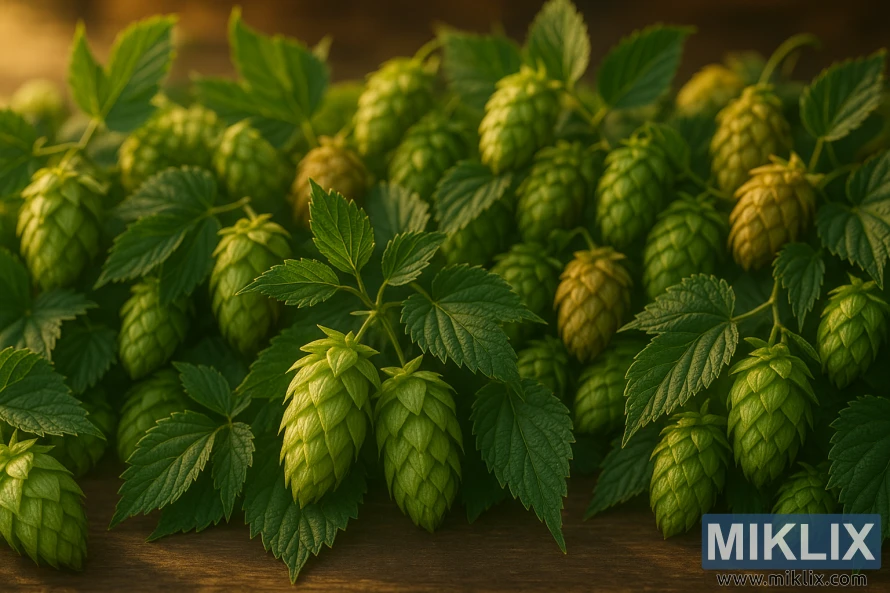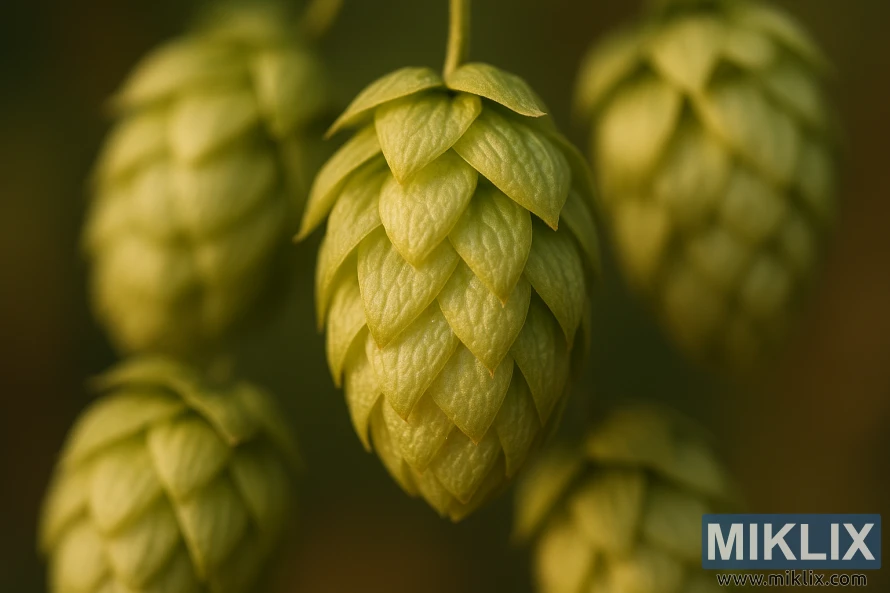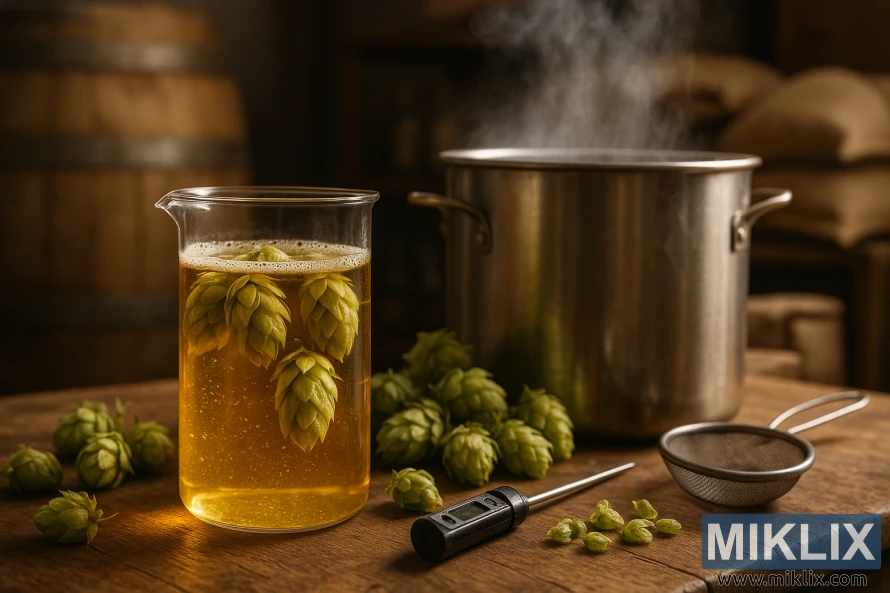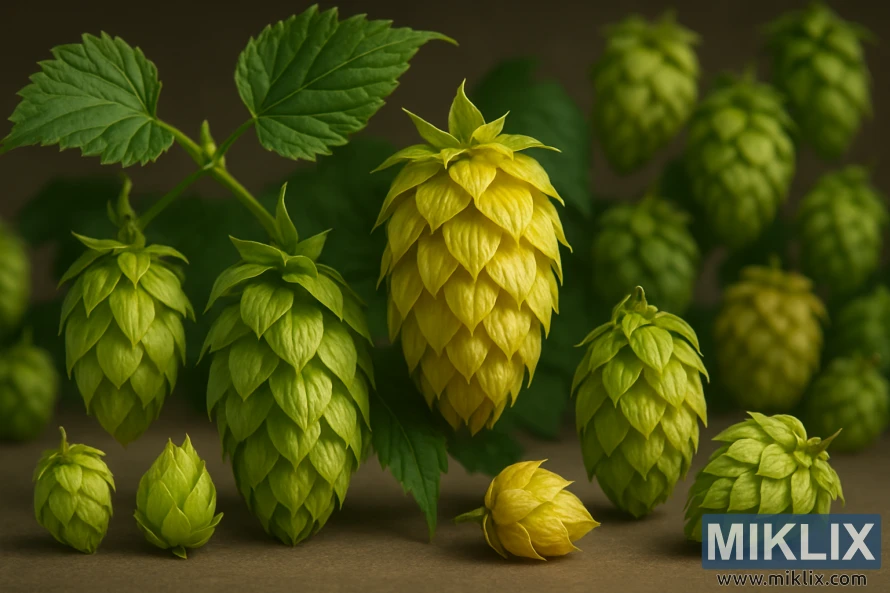Hops in Beer Brewing: Sterling
Published: July 19, 2025 at 9:04:21 PM UTC
Beer brewing is an art that demands precision and the right ingredients. The choice of hop varieties is critical, as it greatly influences the flavor and aroma of the final product. Sterling Hops are a favorite among brewers for their unique blend of flavor and aroma. They are versatile, suitable for a wide range of beer styles. This guide will dive into the significance of Sterling Hops in beer brewing. It aims to equip brewers with a solid understanding of how to effectively use this hop variety in their brewing endeavors.

Key Takeaways
- Understanding the role of hop varieties in beer brewing
- The unique characteristics of Sterling Hops
- How to effectively use Sterling Hops in brewing
- The benefits of using Sterling Hops in various beer styles
- Tips for incorporating Sterling Hops into your brewing process
Understanding Sterling Hops: Origins and Development
The USDA aimed to create a domestic hop alternative to European noble hops. This led to the development of Sterling Hops.
The breeding program for Sterling Hops was started by the United States Department of Agriculture in the late 20th century. The main objective was to produce a hop variety that could match the quality and characteristics of famous European noble hops.
The creation of Sterling Hops involved a detailed process to achieve the desired traits. Key aspects of their development include:
- Genetic background: Sterling Hops were bred to combine desirable characteristics from various hop varieties.
- Breeding objectives: The focus was on creating a hop that could serve as a reliable and high-quality ingredient in American brewing.
- Comparison to other varieties: Sterling Hops were designed to be comparable to European noble hops in terms of aroma and bitterness.
The successful development of Sterling Hops has made them a staple in American craft brewing. They offer brewers a versatile and reliable hop variety.
Essential Characteristics of Sterling Hops
Sterling Hops are prized for their unique blend of alpha acids, beta acids, and oils. This combination makes them a key ingredient in beer brewing. They have a conical shape and moderate size, harvested when mature and dry.
Their chemical makeup is a major reason for their popularity. Sterling Hops contain a moderate amount of alpha acids, between 6% to 9%. This contributes to the beer's bitterness. The beta acid content, though lower, also impacts the flavor and stability.
The oil composition of Sterling Hops is noteworthy. It greatly influences the beer's aroma and flavor. With a balanced oil content, they add floral, spicy, and fruity notes. This enhances the beer's complexity.
The essential characteristics of Sterling Hops can be summarized as follows:
- Moderate alpha acid content (6-9%) for balanced bitterness
- Lower beta acid content contributing to flavor and stability
- A unique oil composition that enhances aroma and flavor
These traits make Sterling Hops versatile for brewers. They are suitable for various beer styles. Their balanced properties allow for a wide range of applications, from pale ales to complex, specialty beers.

Aroma and Flavor Profile
Sterling Hops introduce a unique blend of citrus, herbal, and spicy notes to beer. This combination significantly enhances the beer's flavor and aroma. Their complex aroma and flavor profile are key elements in beer brewing.
The aroma of Sterling Hops is often noted for its citrus, herbal, and black pepper notes. This complex profile stems from their high franescene content, which adds a slightly pungent character. This makes Sterling Hops a favorite among brewers aiming to create beers with distinctive tastes and smells.
The flavor profile of Sterling Hops is equally complex, making them a versatile ingredient for various beer styles. Key flavor notes include:
- Citrus and floral notes that add a bright, refreshing quality to beer.
- Herbal and spicy notes that contribute depth and complexity.
- A slightly pungent character, thanks to their high franescene content, which enhances the beer's overall aroma and flavor.
By utilizing the unique aroma and flavor profile of Sterling Hops, brewers can craft complex and engaging beer flavors. Whether brewing a crisp lager or a hoppy IPA, Sterling Hops provide a versatile and flavorful ingredient. They enhance your beer's character, making it stand out in the market.
Technical Specifications for Brewers
The technical specifications of Sterling Hops are vital for brewers aiming to craft high-quality beers. These details are key to achieving the right balance of bitterness, flavor, and aroma in beer.
Sterling Hops come with specific brewing values that brewers must consider. These include the alpha acid percentage, beta acid percentage, and co-humulone percentage. The alpha acid content is critical as it directly affects the beer's bitterness. Sterling Hops typically have an alpha acid percentage ranging from 6% to 9%.
The beta acid percentage in Sterling Hops also impacts the beer's flavor and stability. While beta acids don't directly affect bitterness like alpha acids do, they are essential for the beer's overall character. The co-humulone percentage is another critical factor, influencing the quality of bitterness. Lower co-humulone levels are often linked to smoother bitterness.
To optimize their recipes and brewing techniques, brewers should consider the following technical specifications for Sterling Hops:
- Alpha Acid Percentage: 6-9%
- Beta Acid Percentage: 4-6%
- Co-humulone Percentage: 20-25%
By understanding and utilizing these technical specifications, brewers can create a wide range of beer styles. These styles can showcase the unique characteristics of Sterling Hops. Whether aiming for balanced bitterness or complex flavors, the technical specifications of Sterling Hops are essential for brewing excellence.
Best Beer Styles for Sterling Hops
Several beer styles are perfectly matched with Sterling Hops. These hops are versatile and complement a wide range of brews. From crisp lagers to complex saisons, they add depth and character.
Sterling Hops are ideal for Pilsners, Lagers, Goldens, and Saisons. Their unique traits enhance the aroma and flavor of these styles. They do so without dominating the beer's overall taste.
- Pilsners: Sterling Hops bring a subtle spice and floral note, perfect for the crisp taste of Pilsners.
- Lagers: Their mild, noble characteristics suit traditional Lagers, adding depth without changing the classic taste.
- Goldens: In Golden ales, Sterling Hops add a sweet and floral flavor, boosting the beer's complexity.
- Saisons: Sterling Hops introduce a spicy and floral twist, fitting well with the style's dryness and complexity.
Understanding Sterling Hops' pairing with various beer styles helps brewers make better choices. Whether crafting a traditional Lager or a Saison, Sterling Hops can elevate your brews. They are a valuable addition to any brewer's toolkit.
Brewing Techniques with Sterling Hops
To fully exploit Sterling Hops, brewers need to employ specific techniques. These methods include dry hopping and late boil additions. Both can greatly boost the beer's aroma and flavor.
Dry hopping with Sterling Hops introduces a complex, floral character to the beer. Key points to consider are:
- Use Sterling Hops in dry hopping to introduce a subtle yet distinctive aroma.
- The quantity of hops used can vary, but typically ranges from 1 to 4 oz per barrel.
- Duration of dry hopping can impact the intensity of the aroma; longer durations can result in a more pronounced character.
Late boil additions are another effective way to incorporate Sterling Hops into your brewing process.
- Add Sterling Hops in the last 15-20 minutes of the boil to preserve their delicate oils and maximize flavor and aroma contributions.
- The quantity for late boil additions typically ranges from 1 to 3 oz per barrel, depending on the desired intensity.
- Combining Sterling Hops with other hop varieties can create a balanced and complex flavor profile.
To achieve the best results with Sterling Hops, brewers should consider the following best practices:
- Balance the bitterness, flavor, and aroma components in your recipe.
- Experiment with different addition times and quantities to find the optimal combination for your beer style.
- Monitor the beer's progress during fermentation and conditioning to ensure the desired characteristics are developing as expected.
By mastering these brewing techniques and understanding the unique properties of Sterling Hops, brewers can create a wide range of high-quality beers. These beers showcase the versatility and complexity of this hop variety.

Hop Addition Timing and Methods
To maximize the Sterling Hops' full flavor, brewers must carefully plan hop addition timing and techniques. The timing and method of hop addition are key factors that shape the beer's final taste, aroma, and character.
The science behind hop utilization is complex. It involves extracting desirable compounds like alpha acids, essential oils, and other hop-derived elements. Different hop addition times and methods significantly impact this extraction process. It's essential for brewers to understand how to optimize hop utilization.
Late boil additions are a common technique used to preserve the delicate hop compounds found in Sterling Hops. By adding hops towards the end of the boil, brewers can minimize the loss of volatile aromatics. This helps preserve the hop's natural flavor and aroma characteristics.
Dry hopping is another method that has gained popularity among brewers. This technique involves adding hops to the beer after fermentation. It allows the hops to infuse their flavors and aromas into the beer without the heat of the boil. Dry hopping with Sterling Hops can enhance the beer's aroma profile, contributing a complex and refreshing character.
- Late boil additions help preserve delicate hop compounds.
- Dry hopping enhances the beer's aroma profile.
- First wort hopping can add depth to the beer's flavor.
The choice of hop addition method depends on the brewer's goals and the style of beer being produced. For example, first wort hopping can add a subtle depth to the beer's flavor. Hop stands can provide a balanced blend of bitterness and aroma.
Understanding the nuances of hop addition timing and methods allows brewers to tailor their brewing techniques to the specific characteristics of Sterling Hops. By experimenting with different techniques, brewers can unlock the full range of beer styles that showcase these versatile hops' unique qualities.
Storage and Handling Requirements
Proper storage and handling of Sterling Hops are essential for maintaining their quality and aroma. Brewers must adhere to best practices to preserve their unique characteristics.
Industry recommendations suggest storing Sterling Hops in cool, dry conditions, away from light. Airtight containers or packaging are critical to prevent air, moisture, and heat exposure.
- Store Sterling Hops in a refrigerator or freezer to maintain their freshness.
- Use airtight containers or packaging to prevent exposure to air and moisture.
- Minimize handling to prevent damage to the hops.
By adhering to these storage and handling practices, brewers can ensure their Sterling Hops remain of high quality. This will contribute to the best brewing results.
Common Brewing Challenges and Solutions
When brewing with Sterling Hops, several challenges can arise, but these can be mitigated with the right techniques. Sterling Hops are known for their unique characteristics, which can be both a blessing and a challenge for brewers.
One of the primary brewing challenges is achieving the right balance of flavors. Sterling Hops have a distinct aroma and flavor profile that can easily overpower other ingredients if not used correctly. To overcome this, brewers should carefully measure the amount of Sterling Hops used and adjust according to the specific beer recipe.
Managing bitterness is another challenge brewers face. Sterling Hops have a moderate alpha acid content, which can contribute to bitterness. Excessive bitterness can make the beer unpalatable. To avoid this, brewers can adjust the timing of hop additions. Adding Sterling Hops later in the brewing process can help preserve their aroma and flavor while minimizing bitterness.
- Carefully measure the amount of Sterling Hops used.
- Adjust hop quantities according to the specific beer recipe.
- Consider the timing of hop additions to manage bitterness.
In addition to balancing flavors and managing bitterness, brewers should also be aware of the storage and handling requirements for Sterling Hops. Proper storage can help preserve the hops' unique characteristics and prevent degradation.
By understanding these common brewing challenges and implementing the right solutions, brewers can unlock the full potential of Sterling Hops and create exceptional beers.
Comparing Sterling Hops to Similar Varieties
In the realm of craft brewing, grasping the differences between Sterling Hops and other varieties is essential. Sterling Hops stand out with their unique traits. Yet, how do they compare to other well-liked hop varieties?
Sterling Hops are often matched with Cascade and Centennial due to their similar alpha acid content and aroma. Yet, Sterling Hops have a distinct flavor that distinguishes them. Here are some key similarities and differences:
- Sterling Hops and Cascade Hops share a similar citrus flavor profile, but Sterling Hops have a slightly sweeter tone.
- Compared to Centennial Hops, Sterling Hops have a lower alpha acid content, making them more suitable for brewers looking for a balanced bitterness.
- Sterling Hops are more disease-resistant than some other popular varieties, making them a more reliable choice for commercial brewers.
When comparing Sterling Hops to other varieties, brewers should consider their beer recipe's specific needs. For instance, if a brewer seeks a hop variety with a strong citrus flavor, Sterling Hops or Cascade Hops might be ideal. On the other hand, if a brewer needs a hop variety with higher alpha acid content, Centennial Hops might be more fitting.
In conclusion, while Sterling Hops share some similarities with other popular hop varieties, their unique characteristics make them a valuable addition to any brewer's toolkit. By understanding how Sterling Hops compare to other varieties, brewers can make informed decisions. This allows them to create distinctive beers that stand out in the market.

Commercial Brewing Success Stories
Sterling Hops have proven their worth in numerous commercial brewing success stories. They've been used by many breweries to craft unique, flavorful beers. These beers attract a broad audience, showing the versatility of Sterling Hops.
A craft brewery successfully brewed a pale ale with Sterling Hops. The hops brought a subtle floral note and crisp bitterness. This complemented the malt, creating a balanced, refreshing beer.
Another example is a large commercial brewery that added Sterling Hops to their IPA. The hops introduced a complex aroma with spice and citrus hints. This enhanced the beer's character, making it a favorite among IPA fans.
- Sterling Hops are celebrated for adding depth and complexity to various beers.
- Breweries value Sterling Hops for their flexibility in bittering and flavor/aroma roles.
- The consistent quality of Sterling Hops makes them a trusted choice for commercial breweries.
These stories highlight Sterling Hops' role in commercial brewing. By using their unique traits, breweries can produce a wide variety of beers. These beers meet diverse tastes and preferences, showing Sterling Hops' versatility.
Sourcing Quality Sterling Hops
Finding reliable suppliers of Sterling Hops is key for consistent beer production. Breweries need to evaluate several factors when looking at suppliers. This ensures they get the best quality hops.
When searching for Sterling Hops, breweries should focus on suppliers that offer detailed hop information. This includes alpha acid content, beta acid content, and storage conditions. This data is critical for assessing hop quality and its impact on the beer's final taste.
- Research the reputation of possible suppliers in the industry.
- Ask for detailed product information, including hop analysis reports.
- Compare prices and services from different suppliers.
- Consider visiting suppliers or attending industry events to see their operations.
It's also important to understand what affects hop quality. This includes the growing, harvesting, and storage conditions. Quality Sterling Hops should be stored in cold conditions. This helps preserve their alpha acids and aromatic properties.
By carefully evaluating suppliers and understanding hop quality factors, breweries can make better purchasing decisions. This improves their beer's flavor and aroma.
Conclusion
Mastering Sterling Hops can elevate your brewery's offerings by adding a unique and complex flavor profile to your beers. As discussed, Sterling Hops offer a versatile and aromatic addition to various beer styles. They are an excellent choice for brewers looking to innovate.
By understanding the essential characteristics, technical specifications, and best brewing practices for Sterling Hops, brewers can unlock new possibilities in their craft. Experimenting with different hop addition timings and methods can further enhance the unique qualities of Sterling Hops.
As the brewing industry continues to evolve, embracing varieties like Sterling Hops will be key to staying ahead in the market. The future of brewing is bright, with endless opportunities to create distinctive beers that captivate audiences. By incorporating Sterling Hops into your brewing repertoire, you'll be well on your way to mastering the art of craft brewing and shaping the future brewing landscape.
Further Reading
If you enjoyed this post, you may also like these suggestions:
